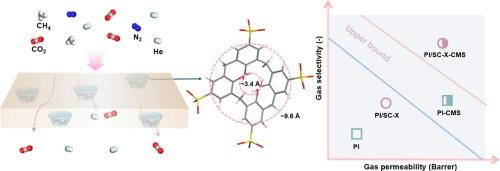Incorporating organic macrocyclic cavitands into polyimide to fabricate high-performance hybrid carbon molecular sieve membranes for gas separation
IF 8.1
1区 工程技术
Q1 ENGINEERING, CHEMICAL
引用次数: 0
Abstract
Precisely controlling the pore structure of carbon molecular sieve (CMS) membranes is essential for optimizing their gas separation performance. In the present work, 4-sulfocalix[4]arene (SC), an organic macrocyclic cavitands (OMC), was incorporated into polyimide (PI) to modulate the pore structure and enhance the gas separation performance of CMS membranes. The results indicated that SC molecules formed multiple disconnected PI-SC chain network regions within the PI matrix, providing additional short-distance rapid transport pathways for CO2 and He, thereby enhancing their permeability. Moreover, the inclusion of SC increased the sp2 C content in the CMS membrane, leading to a more ordered graphite-like carbon structure that enhanced the molecular sieving ability. In addition, by adjusting the content of SC and the carbonization temperature, the resulting PI/SC CMS membranes exhibited enhanced permeability for CO2 and He, along with high gas selectivity. Under optimized conditions, the CO2 and He permeabilities of the PI/SC-5-550 CMS membrane were significantly increased compared to the pure PI precursor membrane (PCO2: 257.2 Barrer vs 1665.9 Barrer; PHe: 260.4 Barrer vs 2578.9 Barrer). Furthermore, the selectivity for CO2/CH4 and He/CH4 increased by approximately 247 % and 378 %, respectively, both surpassing the latest Robeson upper bounds.

求助全文
约1分钟内获得全文
求助全文
来源期刊

Separation and Purification Technology
工程技术-工程:化工
CiteScore
14.00
自引率
12.80%
发文量
2347
审稿时长
43 days
期刊介绍:
Separation and Purification Technology is a premier journal committed to sharing innovative methods for separation and purification in chemical and environmental engineering, encompassing both homogeneous solutions and heterogeneous mixtures. Our scope includes the separation and/or purification of liquids, vapors, and gases, as well as carbon capture and separation techniques. However, it's important to note that methods solely intended for analytical purposes are not within the scope of the journal. Additionally, disciplines such as soil science, polymer science, and metallurgy fall outside the purview of Separation and Purification Technology. Join us in advancing the field of separation and purification methods for sustainable solutions in chemical and environmental engineering.
 求助内容:
求助内容: 应助结果提醒方式:
应助结果提醒方式:


